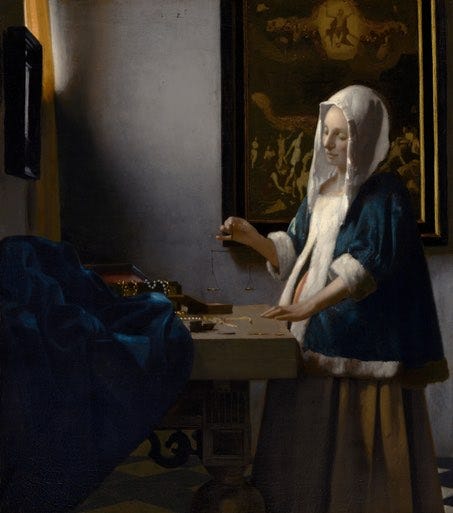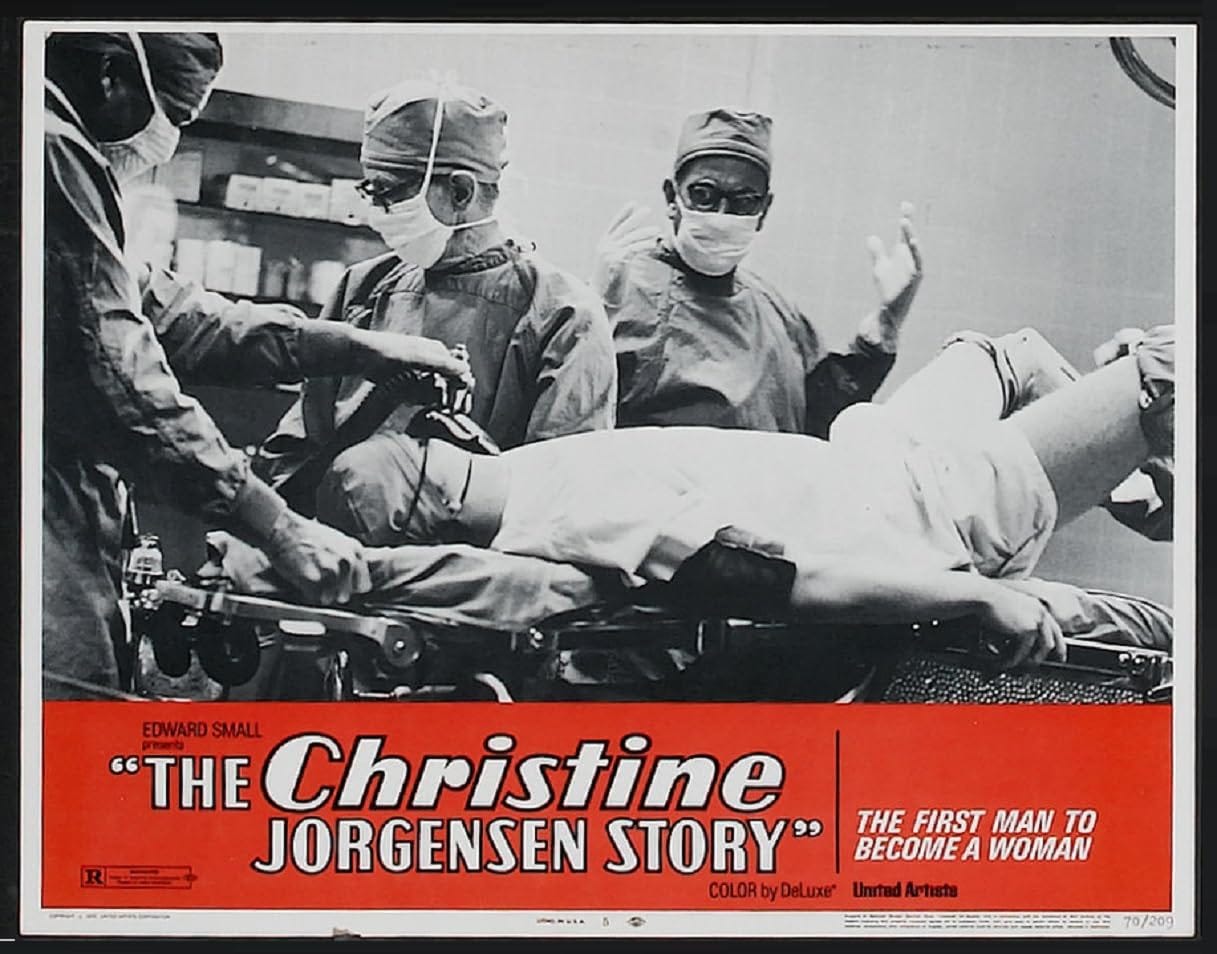Puberty blockers: creating a blank canvas for the surgeon-artist
What if the gender industry stops puberty not to help children, but in pursuit of aesthetic perfection?
Walking through the Vermeer Centrum gallery in the city of Delft, South Holland is an eerie experience. It seems the Dutch painter's home town can no longer exhibit his original 17th century works, due to the global popularity of 'Girl with a Pearl Earring' and his other domestic portraits. Many of the thirty-five works by Vermeer known to survive depict wives and daughters. And so this gallery exhibits digital copies of the artist’s famous paintings, which are themselves two-dimensional representations of living and breathing subjects.
As Baudrillard defined them in his 1981 book, simulacra are representations not of reality, but of other representations, to the extent that the original is lost. Disneyland is not a copy of an actual medieval European city like Delft, but of the representation of such a city in the Disney fairy-tale movies that are a part of Hollywood. Put more crudely, the dream world of the cryogenically-preserved artist is fake, but also located in a city built on fakery. Sheila Faria Glaser, in her English translation of Baudrillard’s Simulacra and Simulation (1994), wrote:
“Disney-land is presented as imaginary in order to make us believe that the rest is real, whereas all of Los Angeles and the America that surrounds it are no longer real, but belong to the hyperreal order and to the order of simulation.”
The techniques which Johannes Vermeer used to create startling pseudo-realism in his paintings of middle-class daily life are explained in a series of exhibits at the Delft gallery. His use of illumination and darkness earned him the epithet of 'The Master of Light', as he created the domestic scenes which were in demand from a new type of patron. Buying fine art was not the exclusive privilege of kings and queens by Vermeer's time. No longer was portrait painting reserved for use in the projection of power, the marriage market of European aristocrats, or the depiction of prized breeding livestock.
The wealth accumulated by the merchant class in the era of global colonisation meant that Dutch merchants and professionals were able to buy and commission original works. Artists of the period manifested a golden era in Dutch painting while earning the guilders or florins of this emergent class. And so domestic interior paintings which featured young girls and women in particular became the subject of Vermeer's most famous art. The ‘Dutch Masters’ competed to create the most attractive works for sale to this new market in a time before photography, when the artist's skill could create unreal things of beauty.
The affluent Dutch of the 17th century wanted to capture their daughters' beauty by investing in the very best paintings, at a time when the colony of ‘New Amsterdam’ was being built on Manhattan Island. Today, parents invest in their children’s bodies to turn daughters into sons, and their sons into daughters
When Christine Jorgensen, born in the Bronx, was depicted on the front page of the New York Daily News on the 1st December 1952, it was under the headline “Ex-GI Becomes Blonde Beauty”. Jorgensen had undergone two years of surgical and medical transition under a Dr. Hamburger in Denmark (yes, really) before returning to the USA for vaginoplasty.
The same soft-focus, hard contrast ‘noir’ aesthetic of feminine beauty in coverage of Jorgensen’s remade body resembled Hollywood studio shots by the new masters of light, at a time when Los Angeles had become became the nexus of both feminine perfection and porn. In 1967, the book “Christine Jorgensen: A Personal Autobiography” was published, and in 1970, Hollywood studio United Artists released the movie “The Christine Jorgensen Story”, leading to a career on the cabaret circuit for its protagonist.
The aesthetic of surgically-constructed gender identity offers the chance to become exactly who we wish to be, as long as someone can pay for the work to be done. If you are too young to remember the early 1980s, you may not appreciate just how big a star Michael Jackson was. In an era when MTV was new, his musical performances fused with Hollywood cinema to create epic video work which sold tens of millions of record albums. Loyal fans continued to support him with their pocket money as he transformed from a young black man to a surgically enhanced, post-racial and trans-feminine adult. It did not go well, with Jackson seemingly addicted to medication as well as repeated cosmetic revisions.
Surgery on primary and secondary sexual characteristics are the simulacra of pornography's representation. Is it a coincidence that these centres of plastic surgery are located within the citadels of the skin trade? The gender clinic which originated the Dutch Protocol for puberty blockade is within a bicycle ride of Amsterdam’s red light district. Historically, painters short of money would re-use old canvases, complete with the brush strokes of the earlier work, previous simulations of reality which can be revealed by X-ray scanning today. The sexed skeleton of the transgender person is revealed by the very same machine.
Eliza Mondegreen recently wrote about how medical justification has been abandoned by the authors of the Dutch Protocol. Her Substack post ‘Doing bad," "doing better"... and letting clinicians off the hook’ was a commentary on the paper ‘Gender-affirming medical treatment for adolescents: a critical reflection on “effective” treatment outcomes’ by Ezra D. Oosthoek, Skye Stanwich, Karl Gerritse, David Matthew Doyle & Annelou L.C. de Vries in the open-access journal BMC Medical Ethics (2024). This paper describes an apparently novel approach to evaluating ‘gender-affirming medical treatment’, or ‘GAMT’, since no practice is valid nowadays until it has an acronym.
Mondegreen wrote “Medical providers and patients alike are under the mistaken and problematic impression that “transition should lead to improvement.” In reality, researchers and clinicians are seeing “the persistence of negative affect throughout and beyond GAMT”: that is, patients continuing to struggle or even doing worse during and after transition.” If the patient wants gender transition, that is now considered sufficient by gender clinics, whatever the physical and mental health outcomes.
What if the purpose of the Dutch Protocol is not to benefit the patient, but to provide a blank canvas for the surgeon-artist in pursuit of aesthetic perfection, free of the tell-tale signs of sexed puberty? If that sounds psychopathic perhaps it is.
The perfectly smooth and unblemished skin of the posed portrait represents commodified youthfulness. While ‘narcissism’ has become an overused word in the era of the black mirror, YouTube videos uploaded in December 2024 by influencer Elena Bateman (with 706,000 subscribers on that platform) stand out. With titles such as ‘*RESULTS* Before and After My Sister had MORE Facial Feminisation Surgery in Korea’
these videos show all-expenses paid surgeries carried out on the host’s trans-feminine sibling, known as Leah, in return for clicks. A comment thread on one video was notably enthusiastic:
“you two look even more alike now and that is a compliment to both of you lol... also how brave is Leah to agree to her face being put on the internet with bruises and swelling all over her face, wrapped in bandages and knocked out by pain killers. I could never.”
“They look so cute next to each other! So obviously sisters!”
“you're so right! gorgeous sisters!”
“I wonder if when leah was like do whatever the first time they just looked at elena and was like yep lets do that.”
In one of these Korean gender surgery tourism videos, Leah’s face is marked up in black ink to show where incisions will be made, and masculine bones will be shaved down with power tools. Elena calls her sibling’s face a ‘human canvas’ for the surgeon’s Sharpies, making the link between elective aesthetic procedures and representations of perfect femininity all too obvious. The painting, as representation, is the simulation. The result of facial feminisation surgery is the simulacra. It does not relate to actual women; it relates to the ideal of a woman as portrayed.
As I watch, YouTube interrupts the recording of Leah’s surgery and recovery process, and an advertisement for online cosmetics store ‘Cult Beauty’ pops up. Its website states: “Our mission? To inspire self-expression and unlock a love of beauty in everyone. We welcome all ages, all faces to join the cult.” Perhaps that is what is meant by truth in advertising.
Dylan Mulvaney’s look for 2023's famous/notorious Bud Light influencer campaign was not a copy of actress Audrey Hepburn, but of her character Holly Golightly in the movie 'Breakfast at Tiffany's' - a neurotic good-time girl in search of an identity, eating breakfast from a paper bag outside the store’s window after a night of partying, wearing a black Hubert de Givenchy dress and a string of pearls. That film was based in turn on the 1958 novella by gay author Truman Capote about a hapless, immature youth who runs away to the big city to work as an 'escort', in the hope of meeting a sugar daddy.
In hindsight, Golightly’s character is a drag performance. The heteronormative sensibilities of the time required Holly to be written as a female character, portrayed on screen by the androgynous, anglo-Flemish Hepburn; the antithesis of the ultra-feminine Marilyn Monroe that Capote had wanted for the part. And the deployment of gender simulacra does seem to have some Bud Light drinkers confused about what is, and what is not, real.
Baudrillard reportedly turned down the opportunity to contribute to sequels of ‘The Matrix’ after seeing the original 1999 movie made by the Wachowski siblings. His work was a critique, not an endorsement, of the hyperreal. The new generation of Dr. Hamburgers might wish to reflect on that.
Genspect publishes a variety of authors with different perspectives. Any opinions expressed in this article are the author’s and do not necessarily reflect Genspect’s official position. For more on Genspect, visit our FAQs.








Thought-provoking stuff. Trans surgery is not for the benefit of the confused, distressed patient but for the 'surgeon artist'. Makes you think.
What a great distillation of the project’s arc and essence. I will go back and read this again but I think it’s the third or fourth piece in the last 2 weeks that have helped me better channel my rage in the direction of the mad scientist. (The first was Stella’s interview of James Linehan.) Society’s tolerance of the mad scientist is its own problem— but is this what ‘sine qua non’ means? Without the evil sociopath, there’s no useful-idiot-enabling-the-sociopath problem.